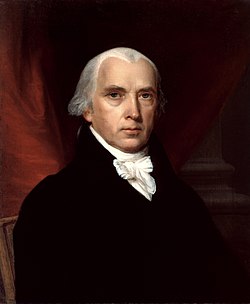
Back James Madison Afrikaans ጄምስ ማዲሰን Amharic James Madison AN Iacobus Madison ANG جيمس ماديسون Arabic دجيمس ماديسون ARY جيمس ماديسون ARZ James Madison AST जेम्स म्याडिसन AWA James Madison Aymara
James Madison | |
|---|---|
 Portrait by John Vanderlyn, 1816 | |
| 4th President of the United States | |
| In office March 4, 1809 – March 4, 1817 | |
| Vice President |
|
| Preceded by | Thomas Jefferson |
| Succeeded by | James Monroe |
| 5th United States Secretary of State | |
| In office May 2, 1801 – March 3, 1809 | |
| President | Thomas Jefferson |
| Preceded by | John Marshall |
| Succeeded by | Robert Smith |
| Member of the U.S. House of Representatives from Virginia | |
| In office March 4, 1789 – March 4, 1797 | |
| Preceded by | Constituency established |
| Succeeded by | George Hancock (5th) John Dawson (15th) |
| Constituency | 5th district (1789–1793) 15th district (1793–1797) |
| Delegate from Virginia to the Congress of the Confederation | |
| In office November 6, 1786 – October 30, 1787 | |
| Preceded by | Seat established |
| Succeeded by | Cyrus Griffin |
| In office March 1, 1781 – November 1, 1783 | |
| Preceded by | Seat established |
| Succeeded by | Thomas Jefferson |
| Personal details | |
| Born | March 16, 1751 Port Conway, Virginia, U.S. |
| Died | June 28, 1836 (aged 85) Montpelier, Virginia, U.S. |
| Nationality | American |
| Political party | Democratic-Republican |
| Height | 5 ft 4 in (1.63 m) |
| Spouse(s) | Dolley Todd Madison |
| Religion | Episcopal Church |
| Signature | |
James Madison Jr. (March 16, 1751 – June 28, 1836) was a Founding Father and the fourth president of the United States from 1809 to 1817. He was also the most important author of the United States Constitution and a slaveowner with a big plantation.[1] Madison was the shortest president in American history, with a height of 5 feet 4 inches (1.63 meters).[2]
- ↑ Spies-Gans, Marcelo Sanchez. "James Madison". Princeton & Slavery. Retrieved 2020-10-27.
In February 1801 Madison Sr. died, leaving Montpelier and more than one hundred slaves to James Madison, as his eldest son. The following week, Thomas Jefferson became President of the United States and appointed Madison as his Secretary of State. Madison managed Montpelier from afar, yet took no concrete steps toward freeing his slaves or changing the plantation system. Upon becoming the fourth President of the United States in 1809, Madison brought slaves to serve him in the White House. One of these slaves was ten-year-old Paul Jennings, whose memoir about White House life—A Colored Man's Reminiscences of James Madison—was published in 1865.
- ↑ "James Madison". NPS.org. Retrieved November 4, 2013.